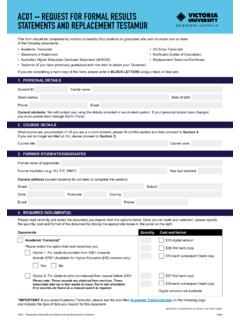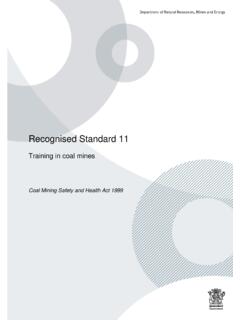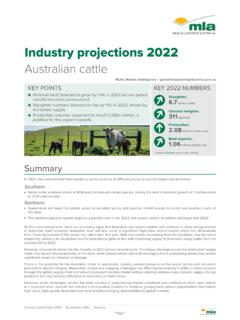Transcription of THE CHANGE IN THE AUSTRALIAN WORK FORCE SINCE THE …
1 Unit 4: Report Writing Research Report THE CHANGE IN THE AUSTRALIAN WORK FORCE SINCE THE END OF WORLD WAR II Prepared by: NAME SURNAME Preparation for Tertiary Studies Course Victorian University of Technology Lecturer: NAME SURNAME 2nd September 2001 Version Concurrent Study Research Report Page 1 Summary This report discusses the changes that have occurred in the AUSTRALIAN workforce SINCE the end of World War II (1945-2000). A review of some of the available literature provides insights into the changing role of women and migrants in the workforce, and the influence of new technologies and changing levels of unemployment have also been considered. Key findings include: There has been a marked increase in women s participation in the workforce, particularly that of married women. While immigration was encouraged in post-war Australia as a way of providing labour for new industries and major projects, the migrant population continues to experience a high rate of unemployment in low-skilled jobs.
2 During the period 1945-2000, the nature of work in Australia has changed with a shift from labour-intensive rural and manufacturing industries to white collar industries like tourism and entertainment. The number and proportion of unemployed people in Australia has risen dramatically, and factors that influence a person s likelihood of experiencing unemployment include age, proficiency in speaking English, and geographic location. The information presented in this report has been gathered from secondary sources, and from AUSTRALIAN Bureau of Statistics data. The report has been prepared for submission as Unit 4 of the Tertiary Studies Course at Victoria University. Version Concurrent Study Research Report Page 2 TABLE OF CONTENTS Summary 2 1 Introduction 4 2 Findings 5 Women s Workforce Participation Rate Table 1. Proportion of women in the manufacturing industry 5 Migrant Workers Participation Rates 6 Employment Categories 7 Unemployment and Demographic Factors 8 3 Conclusion 10 4 Recommendation 10 5 Reference List 11 6 Appendix A: Employment by industry , 1970-1995 12 Version Concurrent Study Research Report Page 3 1 Introduction The profile of the AUSTRALIAN workforce has altered markedly SINCE the end of World War II.
3 Australia has transform ed from a nation of predom inantly Anglo-Celtic culture and almost full em ployment to one of rich cultural diversity with relatively high unemployment. This report exam ines ways in which our workforce has changed, focusing on the f ollowing categories: women s workforce participation rates, m igrant workers participation rates, e mployment categories, unemployment rates and demographic profiles. This repor t will also consider n ew influences affecting the workforce. This report is an assessable com ponent of the Preparation for Tertiary Studies course at Victoria University of Technology, Werribee Campus. Methodology Information for this report was sourced from various secondary sources, all listed in the Reference List. Data from publications by the AUSTRALIAN Bureau of Statistics also proved valuable. This report is not a comprehensive review of the ava ilable literature, but provides a broad overview of the topic.
4 Scope of the report Wherever the term workforce on its own is u sed, it is in reference to the Austr alian workforce. Where the infor mation refers to a particular state, th is will be noted. The period under consideration is 1945 to 2000, although where available data does not cover the entire period, this is stated. The report focuses on several key aspects of the AUSTRALIAN workforce, and is not a com prehensive account of all changes that have occurred in the workforce SINCE World War II. Version Concurrent Study Research Report Page 4 2. Findings Women s Workforce Participation Rates The overall participation rate of women in the AUSTRALIAN workforce SINCE the end of World War II has increased markedly. The absence of male workers during the war brought into the workforce considerable numbers of women who had not been employed before the war broke out (Ryan and Conlon 1989, p. 137). However, many women gave up their jobs when the men returned.
5 Their rates of pay compared to men were reduced in the post-war years (Ryan and Conlon 1989, pp. 140-144). Edna Ryan and Anne Conlon provide the following table, which shows that the proportion of women in the manufacturing industry peaked during the war, declined until 1959, and then began to increase gradually. Table 1. Proportion of women in the manufacturing industry . Males to every 100 females 1932-3 239 1938-9 271 1943-4 237 1944-5 250 1947-8 308 1951-2 315 1954-5 325 1957-8 327 1958-9 330 1961-2 326 1962-3 319 Over the next 29 years, cam paigns for equal pay (or at least for better than 75 per cent of the male rate for the same work) took place across many industries, and this was achieved in principle in 1974 (Ryan and Conlon 1989, ch. 6). In 1945, 24 per cent of the workforce in Australia was women (Zajdow 1995, p. 3). By 1947, this had dropped back to per cent. In 1973, this had increased to 33 per cent (Ryan and Conlon 1989, p.)
6 174). In 1993, wom en made up 52 per cent of the workforce (Zajdow 1995, p. 3). The increase in married women in the workforce has been particularly marked. In 1947 only per cent of wom en in the female labour FORCE were married, or per cent of the total labour FORCE . In 1971 per cent of women in the female labour FORCE were married, or 18 per cent of the total labour FORCE . (Ryan and Conlon 1989, p. 174) Version Concurrent Study Research Report Page 5 Married women s participation increased rapidly after 1971. This is due, in part, to the fact that until the 1950s, women in government employment, including teachers and university staff, had been required to leave their jobs upon m arrying. In 1971, 36 per cent of all m arried women were in paid work. In 1995, 55 per cent of all married women were in paid work. During this time, the proportion of men in paid work declined by 10 per cent, and the proportion of unmarried women has stayed the same (Norris and Wooden 1996, p.
7 2). Much of the growth in wom en s employment has occurred as wom en have moved from the feminine careers of teaching and nursing into respectable white collar industries such as banking and retailing (Game and Pringle 1983, p. 19). Participation in the workforce is uneven across different groups of wom en such as sole parents and Aboriginal and Torres Strait Islanders who have lower rates of participation. However, the particip ation rate of women in general is higher now than at the conclusion of World War II (Zajdow 1995, p3; Ryan and Conlon 1989, p. 174). Migrant Workers Participation Rates The years SINCE the end of the S econd World War have seen an increase in immigration into Australia and therefore an increase in the number of migrants in the workforce. Post-war Australia saw the rapid national developm ent of projects such as the Snowy Mountains Hydro-Electric Scheme. This meant a great demand for labour, which the AUSTRALIAN workforce could not fulfil at the tim e.
8 Migrants were therefore encouraged to come to Australia to f ill such jobs, res ulting in a period of high migrant employment (Carroll 1989, p. 48). Workers born overseas now constitute a substantial proportion of the workforce; however, this group does suffer a high unemployment rate. Some of the reasons for this include their lack of proficiency in English, the undervaluing or lack of recognition of qualifications received overseas, the lack of a verifiable employment history with which to impress employers, discrimination and under-representation in trade unions (VandenHeuvel and Wooden 1996, pp. 7-8). All of these factors are more pronounced among non-English speaking background (NESB) women. Prior to the 1980s, the conventional wisdom was that NESB immigrants, including wom en, had higher rates of labour FORCE participation than their Australia-born By the early 1980s, however, this situation had dramatically altered, such that labour FORCE participation rates of both NESB men and women now lie well below that of Australia-born men and wom en.
9 (VandenHeuvel and Wooden 1996, p. 10) Version Concurrent Study Research Report Page 6 The large increase in married women in the workforce applies only to Austra lia-born women (a 14 per cent increase from 1980-94), and English-speaking background (ESB) migrants (a per cent increase). The proportion of m arried, NESB migrant women in the labour FORCE dropped slightly over the period (VandenHeuvel and Wooden 1996, p. 10). Workforce participation for NESB women varies depending on their country of origin, but overall, their participation has decreased (VandenHeuvel and Wooden 1996, p. 11). Unemployment rates for NESB women show that in 1980 there was little difference from the unemployment rate of 7-8 per cent for women regardless of their country of birth (including Australia). By 1994, figures for Australia-born and ESB women were still at that level, while the ra te for NESB women had peaked at o ver 16 per cent in 1993 before falling to 15 per cent (VandenHeuvel and Wooden 1996, p.)
10 15). Post-war Australia saw a dramatic increase in immigration; however, the migrant population does experience a high degree of unemployment and participation in lower-skilled jobs compared to people born in Australia. Employment Categories The major types of employm ent dominating the workforce at th e conclusion of World War Two differ greatly from the categories of employm ent available in recent times. After 1945, the Governm ent encouraged m anufacturing. This was initially to provide employment for returned servicemen, then later to lower imports as a m eans to ease its balance o f payment difficulties. Rural ind ustries also prospered at this tim e due to a short supply of food and basic commodities in countries badly ravaged by the war. By 1950, 28 per cent of Australians were employed in secondary industries and 17 per cent in prim ary industries (Carroll 1989, p48). The proportion of Australians employed in these areas has SINCE fallen.












